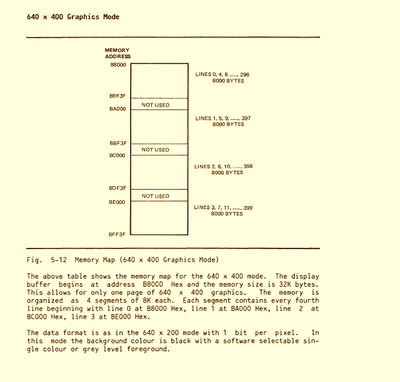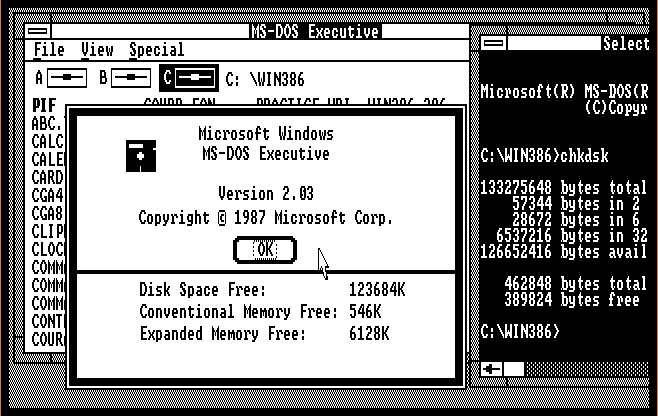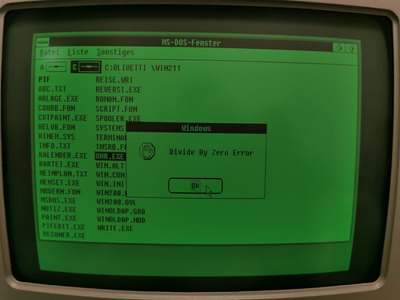There's something about Commodore I didn't understand, though.
Their PC range of computers of the 1980s had an "AGA" graphics card installed (not to be confused by the Amiga's AGA chipset).
And this card/chip was clearly supperior to CGA.
Edit: Specs available here: http://www.zimmers.net/cbmpics/cbm/miscCPUs/pcinfo.txt
How comes that the Amiga sidecar and bridgeboard have no support for those Super CGA modes?
Or the real industry standard, Hercules?
No one in his right mind used plain I MDA boards anymore.
720x348 was what people used on PC when they needed reasonable graphics output.
Sure, doing 350 lines is tricky on a TV set if you don't like interlacing.
But it would have been possibly, if scrolling was used. It's not that bad for GUIs, after all.
Usually, you don't need the whole screen all the time.
Application windows can be moved into the visible viewport, also. .
640x400 b/w wasn't difficult to implement, either, even if Commodore had no engineers left.
A student could have had hacked support onto the existing hardware/software.
Plantronics would also have been possible.
All it needs were 16KB more memory for CGA, maybe.
I say maybe, because CGA uses 16KB of actual picture information.
Due to an address decode error, the data is beeing mirrored/doubled on some systems.
So the frame buffer may already be 32KB large in total.
This would have allowed easy image transfer between Janus software and Amiga/PC hardware.
As long as the data is within a 64KB window, data is available "linear" and no segmentation is necessary.
That's something I always wondered. Second is the 640KB limit.
With merely MDA or CGA emulation available within the Janus software, it's no problem to access 704 to 736KB of conventional memory.
In fact, this would have been an excellent opportunity for the CBM Amiga to be supperior to a real IBM PC/XT.
I seriously don't understand all these missing opportunities.
The engineers who made the PC hardware simply had to know this, they couldn't have been that ignorant here.
I mean, in the mid-80s, hobbyists published a lot of hacks for the IBM PC to make that possible.
And the files were available world-wide, via BBS, Fido-Net, early internet/e-mail at universities, online services like CompuServe, shareware diskettes, via X.25 networks or via Packet-Radio (AX.25).
If the CBM dudes were wise, they could have made a third video mode available: Terminal.
DOS supports operation via serial terminal, like CP/M.
That way, about 900 KB of conventional memory can be possible.
Ideal for developers that run out of memory when they do compile/link larger projects!
As far as I know, the German CT'86 DOS computer did exactly take advantage of this.
It had no video, but was text based.
Edited.
Edit: I'm not sure if that's the right place to discuss this, though. 🤷♂️
I simply wrote down what came to mind.
Also, if source code of the Janus software eventually shows up, it likely could be patched to support a 640x400 b/w mode (Olivetti M24, Toshiba T3200 etc). So there's hope.
Edit: Never mind, found the answer. According to this interview, all the Commodore bridgeboards were made in Germany.
https://www.commodore.international/qlink/html/amiga0413.htm
Considering our German mentality (alles Fachidi*ten/all one trick ponies), I'm not surprised the software support was lacking. 🙄 *sigh*
The dudes writing it were probably stuck in 1981 or something, without access to any current PC magazines.
Otherwise, they had implemented 640x400 Olivetti mode, at least. The Amiga 1000 had no problem displaying 640x400 resolutions, which the interview confirms.
Even EGA would have been possible at 630x350, albeit slowly.
Edit: Monochrome EGA in 640x350 was an option, too.
Many software titles supported it. It was worse than Olivetti mode, but well supoorted.
Performance was similar good.
Edited.
Edit: I've found a nice picture of 640x400 mode drawing a GUI (the green one).
The 400 lines quite make a difference, everything is nolonger being squished.
And it's not even difficult to implement on top of existing CGA support.
Especially if physical CGA memory in system is 32KB wide already (frame buffer/pass-trough), to account for the CGA addressing "bug" (a CGA page is 16KB, but memory between 0xB8000-0xBFFFF is repeated twice; real IBM CGA decodes only on the lowest 10 bits?).
That's less than what Hercules would normally need (two pages of 32KB each; 64KB total) for full compatibility.
And since 640x400 is a CGA superset, no additional 32KB page is required be left available for CGA emulation..
Because, that's what CGA emulators for Hercules PCs make use of often:
The second page isn't active, but available, so that CGA picture data isn't being sent into the void.
Rather, it's being hold by the unused Hercules memory to be processed by the CGA emulator program.
That being said, I hope it's okay to edit this posting, after the discussion already happened.
I don't mean to be right, but merely want to explain myself here.
The pictures maybe help to express what I meant to say (my wording wasn't exactly good).





